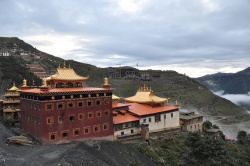Katok Monastery
Katok Monastery (Wylie: kaḥ thog) is listed in various enumerations as one of the six principal Nyingma Monasteries, one of the main lineages of Tibetan Buddhism.
Katok Monastery (Tib. ཀཿཐོག་, Wyl. kaHthog) aka Katok Dorje Den (Tib. ཀཿཐོག་རྡོ་རྗེའི་གདན་, Wyl. kaHthog rdo rje'i gdan) — the oldest of the Six "Mother"Nyingma Monasteries. It was founded by Katok Dampa Deshek, younger brother of Phagmodrupa Dorje Gyalpo, in 1159, above Horpo, in East Tibet. The site is considered to be one of twenty-five holy places of Eastern Tibet and represents the main holy place of enlightened activity. After the original monastery had fallen into disrepair, a new monastery was built on the site in 1656 by Tertön Rigdzin Düddul Dorje (1615-1672) and Rigdzin Longsal Nyingpo (1625-1692). There were approximately 800 monks at the monastery before the Chinese invasion of Tibet.
The monastery had a reputation for fine scholarship and produced some of the greatest scholars in Tibetan history, such as Katok Rigdzin Tsewang Norbu (1698-1755) and Getse Pandita Gyurme Tsewang Chokdrup (b. 1761). More recently, Katok Situ Chökyi Gyatso and Khenpo Ngawang Palzang, aka Khenpo Ngakchung, were among the greatest lamas associated with the monastery.
Katok Monastery was founded in 1159 by a younger sibling of Phagmodrupa, Katok Dampa Deshek. The original gompa fell into disrepair and was rebuilt on the same site in 1656 through the impetus of Tertön Düddul Dorje (1615–72) and the Terton Rigdzin Longsal Nyingpo (1625-1682/92 or 1685–1752). Katok Monastery held a reputation of fine scholarship. It is held that prior to the annexation of Tibet by the Chinese in 1951, that Katok Monastery housed circa 800 Monks.
Katok was long renowned as a center specializing in Kama (as opposed to Terma), and as a center of monasticism, although both of these features were disrupted under Longsel Nyingpo (1625–1692).
According to The Tibetan Buddhist Resource Centre, disciples of Kenpo Munsel and Kenpo Jamyang at Katok Monastery in 1999 compiled a Katok edition of the 'Kama' (Wylie: bka' ma shin tu rgyas pa (kaH thog)) in 120 volumes: "...twice the size of the Dudjom edition, it contains many rare Nyingma treatises on Mahayoga, Anuyoga, and Atiyoga that heretofore had never been seen outside of Tibet."
== Anuyoga ==
Kathog Monastery became a bastion of the Anuyoga tradition when it became neglected by other Nyingmapa institutions. The 'Compendium of the Intentions Sūtra' (Wylie: dgongs pa ’dus pa’i mdo) the root text of the Anuyoga tradition was instrumental in the early Kathog educational system. Nubchen Sangye Yeshe wrote a lengthy commentary on the Compendium of the Intentions Sūtra rendered in English as 'Armor Against Darkness' (Wylie: mun pa’i go cha).
The name Katok means "above the Ka" and refers to the sacred geography of the land on which it was founded. The founder, Dampa Deshek (1122-1192), was told by his lama to seek out a rock formation in the shape of the Tibetan letter Ka (ཀཿ) and build a monastery upon it.
Founded in 1159, Katok was the first large center for monasticism and scriptural studies in Kham and upon its founding quickly attracted many monks. Katok Monastery is well known for its curricular specialization in the rituals and philosophies of the Nyingma Kama, liturgical and commentarial works based on canonical tantras. The extant writings of Katok lamas runs to several dozen volumes and over the centuries many Katok lamas have been broadly influential in Nyingma scholarship. Lamas from Katok have also founded branch monasteries throughout the Tibetan cultural world. Beyond its numerous branch monasteries in Kham, Katok also maintains branches in southern Tibet and Bhutan.
Katok lies on the side of a mountain in a valley off the Dzing river in an area called Horpo. Horpo was acquired by the Derge kingdom during the latter's initial rise to power in the middle of the seventeenth century. Since then Katok lamas have been chaplains to the Derge royal family and the monastery enjoyed their financial support. The king and queen would attend festivals at the monastery and regularly invite the lamas to their palaces to perform rituals and give advice. An especially high point in the relationship between Derge and Katok was the period in the late eighteenth century when queen Tsewang Lhamo commissioned Katok lama Tsewang Chokdrup (also known as Getsé Mahapandita) to be the chief editor for several major printing projects at the Derge Printing House. The Derge kingdom ended in the early 20th century and Katok is now part of Pelyul County, Ganzi Tibetan Autonomous Prefecture in Sichuan.
Katok was destroyed during the Cultural Revolution. Rebuilding began in the 1980s and now that all of its old temples have been restored, new temples are now under construction. The monastery has three major divisions: the ritual college, seminary, and retreat center. The seminary is the most numerous and visible, with three hundred monks who attend classes in the main hall every day. The monasteries finances are strong thanks to the generous donations of Han Chinese disciples of Katok lamas. Nevertheless because of its remote mountaintop location the monastery is accessed by dangerous dirt roads and only became connected to the county's electricity grid in 2007.
== Lauded scholars seated at Katok Monastery ==
- Katok Rigdzin Tsewang Norbu (1698–1755)
- Getse Mahapandita Gyurme Tsewang Chokdrup (b. 1761)
- Katok Situ Chökyi Gyatso (1880-1923/5)
- Khenpo Ngawang Palzang (also known as Khenpo Ngakchung)
- Katok Situ Chökyi Nyima (1928–1962, Katok Situ Rinpoche died of starvation in Gothang Gyalgo prisoner camp)
